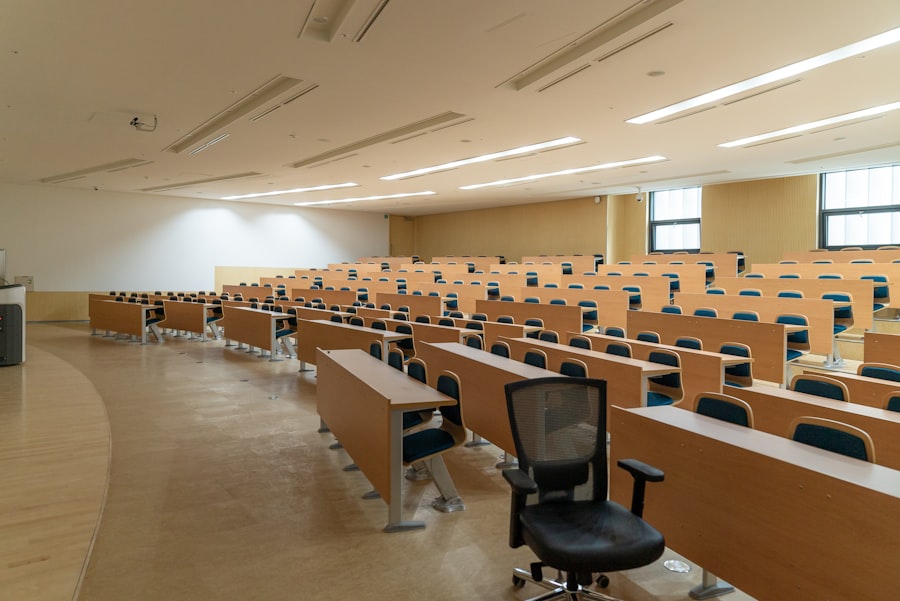
Ruined Academy Life: Chapter 7 – The Aftermath
In the wake of the academy disaster, the atmosphere was thick with disbelief and sorrow. The incident, which had claimed lives and left many injured, sent shockwaves through the community. The once vibrant halls of learning, filled with laughter and the sounds of academic pursuit, were now shrouded in a somber silence.
Students and faculty alike grappled with the reality of what had transpired, struggling to comprehend how such a tragedy could occur in a place that was meant to be a sanctuary for growth and knowledge. The immediate response involved emergency services rushing to the scene, providing medical assistance and support to those affected. However, the emotional toll was far more complex and would require a long-term commitment to healing.
As news of the disaster spread, the community rallied together, but the initial reactions were marked by confusion and fear. Parents rushed to the academy, desperate for information about their children’s safety. Social media became a double-edged sword; while it served as a platform for sharing updates, it also fueled rumors and misinformation.
The local news outlets were inundated with calls from concerned citizens seeking clarity. In the days that followed, memorials began to spring up around the academy, with flowers, candles, and heartfelt messages adorning the entrance. These tributes served as a poignant reminder of the lives lost and the indelible impact of the tragedy on the community.
Key Takeaways
- The aftermath of the academy disaster has left a deep impact on the entire community, with widespread trauma and grief.
- Both students and faculty have been significantly affected by the disaster, with many struggling to cope with the emotional aftermath.
- Rebuilding efforts and support systems have been put in place to help the academy community heal and move forward.
- Coping with trauma and grief has been a major focus for the academy, with counseling and mental health support being provided to those in need.
- Lessons learned from the disaster have led to changes being implemented to ensure the safety and well-being of the academy community in the future.
The impact on students and faculty
The impact of the disaster on students was profound and multifaceted. Many students experienced a range of emotions, from shock and anger to deep sadness and confusion. For some, the event triggered feelings of vulnerability that they had never encountered before.
The academy had been a place where they felt safe and secure, and now that sense of safety had been irrevocably shattered. Students who had witnessed the event firsthand faced particularly intense psychological challenges, often struggling with intrusive thoughts and flashbacks that disrupted their daily lives. The academic environment shifted dramatically; classrooms that once buzzed with enthusiasm became spaces filled with anxiety and uncertainty.
Many educators found themselves grappling with their own grief while trying to support their students through this harrowing experience. Teachers who had built strong relationships with their students felt an overwhelming sense of responsibility to help them navigate their trauma.
Professional development sessions that once focused on pedagogical strategies were replaced with discussions on mental health awareness and trauma-informed teaching practices. The faculty’s resilience was tested as they sought to create a supportive environment amidst their own struggles, often leaning on one another for emotional support.
Rebuilding efforts and support systems

In the aftermath of the disaster, rebuilding efforts became a priority for both the academy administration and the broader community. Recognizing that physical reconstruction was only one aspect of recovery, leaders initiated comprehensive support systems aimed at addressing the emotional and psychological needs of students and faculty alike. Counseling services were expanded, with trained professionals available to provide individual and group therapy sessions.
Workshops focused on coping strategies were organized, allowing participants to share their experiences in a safe space while learning techniques to manage their grief and anxiety. Community involvement played a crucial role in these rebuilding efforts. Local organizations stepped in to offer resources, including mental health support and financial assistance for families affected by the tragedy.
Fundraising events were organized to help cover medical expenses and provide scholarships for students who had lost family members or guardians in the disaster. The academy also established partnerships with mental health organizations to ensure ongoing support for those in need. This collaborative approach not only facilitated immediate assistance but also fostered a sense of solidarity within the community as they worked together toward healing.
Coping with trauma and grief
| Category | Metrics |
|---|---|
| Therapy | Number of therapy sessions attended |
| Support Groups | Number of support group meetings attended |
| Self-care | Hours of self-care activities per week |
| Journaling | Frequency of journaling about emotions |
Coping with trauma and grief is an intricate process that varies significantly from person to person. For many students, engaging in creative outlets became a vital means of expression during this challenging time. Art therapy sessions were introduced, allowing students to channel their emotions into tangible forms of creativity.
Through painting, writing, or music, they found ways to articulate feelings that were often too complex to verbalize. These sessions not only provided therapeutic benefits but also fostered connections among participants who shared similar experiences. In addition to creative expression, peer support groups emerged as an essential component of coping strategies.
Students gathered in small circles to share their stories, listen to one another, and offer mutual encouragement. These gatherings created a sense of belonging and understanding that was crucial for healing. Faculty members also participated in similar groups, recognizing that sharing their experiences could help normalize feelings of grief and loss within the community.
The act of coming together in shared vulnerability allowed individuals to feel less isolated in their pain.
Lessons learned and changes implemented
The academy disaster served as a catalyst for reflection and change within the institution. In its aftermath, administrators conducted thorough assessments of existing safety protocols and emergency response plans. They recognized that while physical safety measures were essential, fostering an environment that prioritized mental health was equally important.
Workshops on resilience, emotional intelligence, and stress management became integral components of student life. Furthermore, the academy established a task force dedicated to ongoing evaluation of safety measures and mental health resources.
This group included students, faculty members, mental health professionals, and community leaders who collaborated to ensure that lessons learned from the tragedy would inform future practices. Regular training sessions for staff on recognizing signs of distress in students were instituted, equipping educators with tools to identify those who might be struggling silently. This proactive approach aimed not only to prevent future tragedies but also to create a culture where mental health was openly discussed and prioritized.
Moving forward and finding closure

As time passed, the academy community began to find ways to move forward while honoring those who had been lost. Memorial services were held annually to commemorate the victims, providing an opportunity for reflection and remembrance. These gatherings became a cornerstone of healing for many families and friends who sought solace in shared memories and collective mourning.
The academy also established scholarships in memory of those who had died, ensuring that their legacies would continue through future generations of students. The journey toward closure was not linear; it involved setbacks and moments of renewed grief. However, as individuals began to rebuild their lives, they discovered new ways to honor their experiences.
Some students took on leadership roles in advocacy groups focused on mental health awareness, using their voices to promote change within the academy and beyond. Faculty members engaged in research related to trauma-informed education practices, contributing to a broader understanding of how educational institutions can better support students facing adversity.
Support for the affected families
The families affected by the disaster faced an uphill battle as they navigated their grief while seeking support from various sources. The academy administration recognized this need early on and established dedicated outreach programs aimed at providing assistance tailored specifically for these families. Regular check-ins were conducted by counselors who offered emotional support as well as practical resources such as financial aid for medical bills or counseling services.
Community organizations also played a pivotal role in supporting affected families through fundraising initiatives designed to alleviate some of their burdens. Local businesses contributed by hosting events where proceeds went directly to families impacted by the tragedy. These efforts not only provided financial relief but also fostered a sense of community solidarity that was crucial during such trying times.
Rebuilding trust and restoring the academy community
Rebuilding trust within the academy community was an essential aspect of recovery following the disaster. Many students and faculty members felt betrayed by a system they believed should have protected them. To address these concerns, open forums were organized where individuals could voice their feelings about safety measures and institutional responses during the crisis.
These discussions allowed administrators to acknowledge shortcomings while demonstrating a commitment to transparency moving forward. Additionally, initiatives aimed at fostering connection among students were implemented as part of rebuilding efforts. Social events designed to encourage interaction across different grade levels helped bridge gaps created by fear and mistrust.
By creating opportunities for collaboration and dialogue, the academy sought not only to restore its sense of community but also to empower individuals to take an active role in shaping its future. Through these multifaceted approaches—addressing emotional needs, implementing policy changes, providing support for affected families, and fostering open communication—the academy began its journey toward healing and renewal after an unimaginable tragedy. Each step taken was a testament to resilience in the face of adversity, illustrating how communities can come together to rebuild not just structures but also trust, hope, and a shared commitment to one another’s well-being.
FAQs
What is the article “My Ruined Academy Life Chapter 7” about?
The article “My Ruined Academy Life Chapter 7” is a part of a series that narrates the experiences of the protagonist in dealing with challenges and setbacks in their academic life.
What can readers expect to find in “My Ruined Academy Life Chapter 7”?
Readers can expect to find the continuation of the protagonist’s story, including the events, struggles, and developments that occur in their academic journey.
Is “My Ruined Academy Life Chapter 7” a standalone piece or part of a series?
“My Ruined Academy Life Chapter 7” is part of a series, and it is recommended to read the previous chapters to fully understand the protagonist’s journey and the context of their experiences.
Where can I access “My Ruined Academy Life Chapter 7”?
“My Ruined Academy Life Chapter 7” may be available on the author’s website, a literary platform, or in a published book or magazine. Readers can check the author’s official channels or relevant publications for access to the chapter.
Is “My Ruined Academy Life Chapter 7” suitable for all audiences?
The suitability of “My Ruined Academy Life Chapter 7” for different audiences may vary depending on the content and themes explored in the chapter. It is advisable to review the content warnings or ratings provided by the author or publisher to determine its appropriateness for specific audiences.



